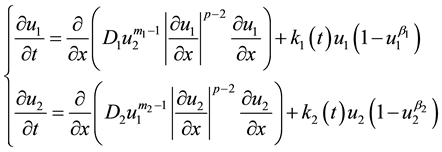Qualitative Properties and Numerical Solution of the Kolmogorov-Fisher Type Biological Population Task with Double Nonlinear Diffusion ()
1. Introduction
Let’s consider in the domain  parabolic system of two quasilinear equations of reaction-diffusion with double nonlinear diffusion
parabolic system of two quasilinear equations of reaction-diffusion with double nonlinear diffusion
 (1)
(1)

which describes the process of biological populations of the Kolmogorov-Fisher in two-component nonlinear medium, the diffusion coefficient which is equal to ,
,  , where
, where 
are positive real numbers, and ,
,  are sought solution .
are sought solution .
Below we investigate the qualitative properties of the considered problem by constructing self-similar system of equations for (1).
2. Self-Similar System of Equations
Self-similar system of equations we will construct by the method of nonlinear splitting [1] - [3] .
Substitution in (1)

lead (1) to the form:
 (2)
(2)

Choosing
 ,
,
we get the following system of equations:
 (3)
(3)
where
 ,
,
 ,
,
For the purpose of obtaining self-similar system for the system of Equation (3) we find first the solution of a system of ordinary differential equations [4] - [7]

in the form
![]()
where
![]()
And then the solution of system (3) is sought in the form
![]() (4)
(4)
and ![]() is selected so
is selected so
![]()
if![]() .
.
Then for ![]() we get the system of equations
we get the system of equations
![]() (5)
(5)
where
![]() (6)
(6)
Consider the self-similar solution of system (5) of the form
![]() (7)
(7)
Then substituting (7) into (5) with respect to ![]() we get the following system of nonlinear degenerate self-similar equations:
we get the following system of nonlinear degenerate self-similar equations:
![]() (8)
(8)
where![]() ,
, ![]() Let’s build an upper solutions for system (8).
Let’s build an upper solutions for system (8).
3. Construction an Upper Solution
If
![]() , , ,
, , ,
Equation (8) has a local solution of the form
![]()
where![]() ,
, ![]() ,
,
![]()
Then in the domain Q according to the comparison principle of solutions [1] [8] we get
Theorem 1. Let ![]() Then the solution of the task (1) in the domain Q takes place an estimation
Then the solution of the task (1) in the domain Q takes place an estimation
![]()
where![]() ―above-defined functions.
―above-defined functions.
Note that the solution of system (1) when ![]() has the following representation in the
has the following representation in the
![]() .
.
where![]() ―Beta Euler function [9] .
―Beta Euler function [9] .
It is proved that this view is self-similar asymptotics of solutions of systems (1).
![]()
Thence
![]()
![]() .
.
Carried out computational experiments and numerical results are obtained (see Table 1, Table 2).
4. Conclusion
Thus, it is assumed that the possibility of adequate study of nonlinear equations, biological populations with double nonlinearity based on the method of nonlinear splitting and numerical study of nonlinear processes described by equations with double nonlinearity and analysis of results on the basis of the estimates of the solutions gives a comprehensive picture of the process of multicomponent competing systems of biological populations.
5. Results
![]()
![]()
Table 1. Numerical results in the case of fast diffusion.
![]()
Table 2. Numerical results in the case of slow diffusion.
1) Fast diffusion is shown in Table 1. As an initial approximation it is necessary to take:
![]() ,
, ![]() ,
, ![]() ,
, ![]() ,
, ![]() ,
, ![]() ,
, ![]()
Parameter values must be ![]() Constant a is determined from the condition
Constant a is determined from the condition![]() ,
,![]() :
: ![]()
2) Slow diffusion is shown in Table 2. As an initial approximation it is necessary to take:
![]() ,
, ![]() ,
, ![]() ,
, ![]() , т,
, т, ![]() ,
, ![]()
Parameter values must be![]() . Constant a is determined from the condition
. Constant a is determined from the condition
![]()